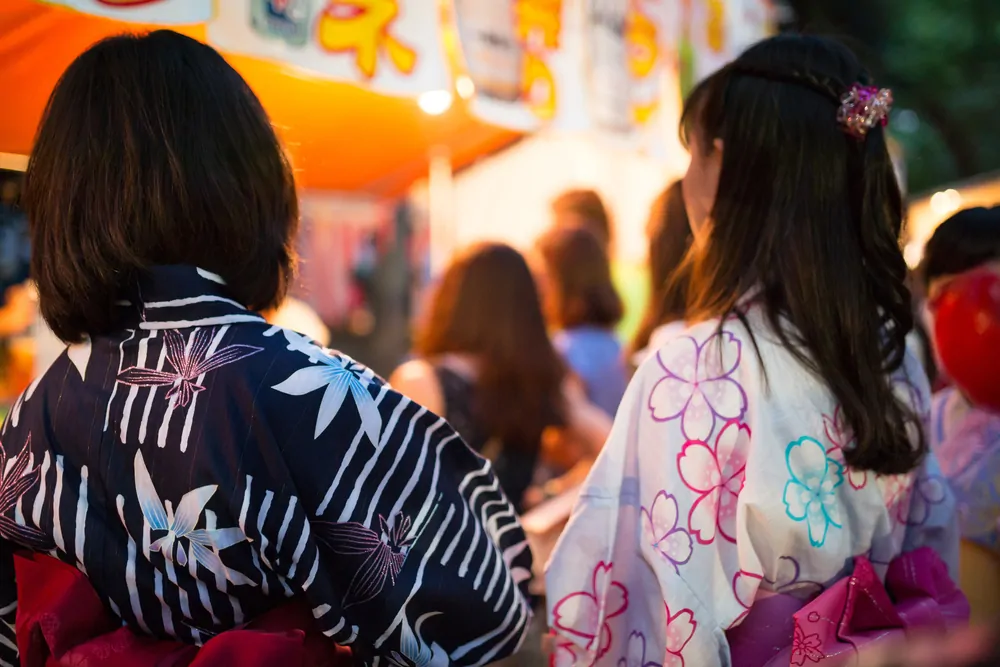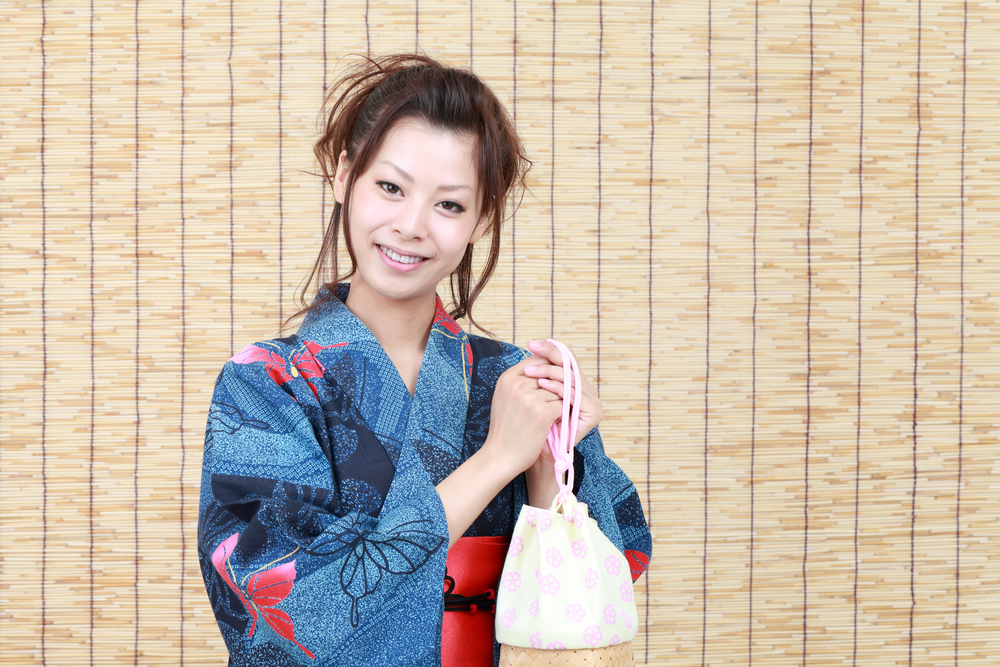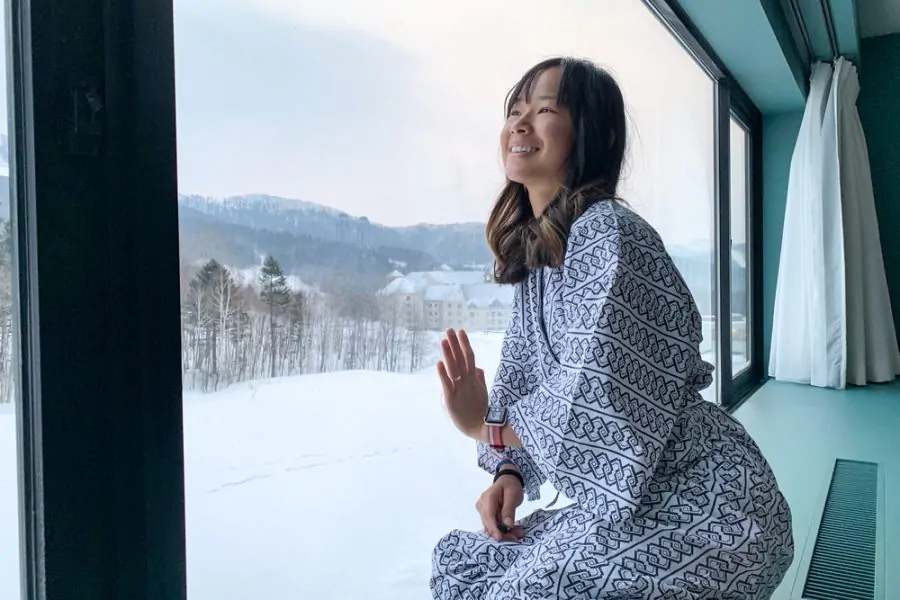Have you ever worn a yukata before? It’s a thin summer kimono typically worn at traditional outdoor festivals (matsuri) on hot summer days or sometimes in the bedroom as pajamas.
Yukata have become increasingly popular in recent years and can be found in most major cities throughout Japan. Foreign tourists enjoy wearing traditional Japanese clothing while taking a stroll in the streets of ancient cities like Kyoto or Nara.
Let’s take a closer look at this traditional garment. By reading this article, you will know how to don a yukata like authentic Japanese do, when and where to wear it, and what to wear with it!
- >The men women woven kimono bathrobe for summer,spring,and early autumn,is made of double-layer gauze cotton,is so soft ,breathable,comfortable,skin-friendly, Lightweight,thin and cool
- >The design of the casual loose pajamas is simple luxurious and cozy.The night gowns is pure color,is side- open which easy to put on and take off ,has front pocket to place phones, keys, and small items. V-neck style
- >Medium Size : Bust 44.9in/114cm, Length 40.2in/102cm, Sleeve Length 16.1in/41cm.The Japanese style kimono pajama is adjustable.loose and tie closure,you can tie a knot depending on the comfort,one size fit most
- >Multifunctional and Universal.The bathrobe can be used as home wear,sleepwear, nightwear,night robe,nightgown,lounge wear,sauna robe ,Spa kimono pajama,loose yukata,spa swim cover,hotel spa kimono,kimono bathrobe,sweat suit short Spa robes
- >Perfect for bath, pool, swim, vacation, spa, hotel,home,party ,sauna and gym
- Size M@height 165cm-170cm(5ft 4in-5ft 6.93in)
- Size L@height 170cm-175cm(5ft 6.93in-5ft 8.9in)
- Size XL@height 175cm-185cm(5ft 8.9in-6ft 0.83in)
- Size XXL@height 185cm-(6ft 0.83in over)
- The name Yukata comes from Yu(bath) and Katabira (under-closing).
- 【MATERIAL】: 100% cotton gauze fabrics. Advantages: breathable and sweat-absorbent, skin-friendly and soft.
- 【Large Size】: Chest 120 cm (46.46 inches), Skirt length 104 cm (42.13 inches), Sleeve length 46 cm (16.54 inches). Recommended People height 160-170 cm. Recommended weight 132.28-165.35 lbs.
- 【ELEGANT DESIGN】: Kimono collar, belt loops and inside ties. Tie closure. There are pockets on both sides. Continuous cutting sleeves wrap design, loose hem. French seam finish.
- 【GIFT】Designed for ultimate comfort and versatility, this piece doubles as cozy sleepwear and relaxed loungewear, making everyday life effortlessly convenient and stylish. It is a good choice to give it to friends as a gift. Our Japanese bathrobes can be Christmas gifts, birthday gifts, Thanksgiving gifts, Valentine's Day gifts, anniversary gifts, New Year gifts.
- 【EASY CARE】: machine wash on cold, and dry on low heat in the dryer to avoid shrinkage.
What is a Yukata: A Little Background
A yukata is a traditional Japanese garment. They are usually made of lightweight cotton or linen and are typically printed with colorful designs, such as flowers or geometric patterns. They are worn with an obi, or sash, around the waist. Yukata can be worn by both men and women and are usually seen during the summer months.

Yutaka made its first appearance around the 8th century in Japan and was initially called yukatabira. In traditional Japanese culture, people would take baths in public bathhouses and then put on yukata to walk home. Yukata literally means “bathing cloth” and originally referred to the clothes worn after a bath.
The yukata culture became more prevalent at the end of the Edo period (1603 – 1867) because the number of public bathhouses increased significantly. It was seen as an after-bath gown and as casual streetwear that the people adopted. Despite this, the yukata became less common after World War II because the Japanese lifestyle blended more westernized influences.
Today, yukata are generally only worn by Japanese people on special occasions. While yukata designs have changed over time, they continue to be a popular choice for those seeking a traditional Japanese look. Although there are men’s and women’s yukata, the designs and colors tend to be different.
Male yukata generally have darker colors, while those for young women are often colorful, with trendy floral designs.
When to Wear a Yukata?
1 – Natsu Matsuri (Summer festivals)

Nowadays, yukata is most commonly worn at summer festivals (natsu matsuri), celebrated in cities and villages all over Japan. The word “matsuri” literally means “festival,” and there are hundreds of different matsuri held throughout the year to commemorate everything from the changing seasons to historical events.
Each matsuri has its unique atmosphere and traditions, but they all typically involve food stands, carnival games, and traditional dances (Bon odori).
If you have ever been to a Japanese summer festival, you have probably seen many people in yukata! As long as you are in Japan between June and August, you might come across people wearing yukata in the streets, even if there is no matsuri!
Summer is the only period when you can naturally wear a yukata outside.
2 – Hanabi Taikai (Fireworks festivals)

Summer fireworks festivals in Japan, known as ¨hanabi taikai¨, are a popular way to enjoy the warm weather and celebrate with family and friends. Fireworks are set off throughout the night, providing a spectacular show for onlookers.
Many of these festivals also feature traditional Japanese food and dances, making them an excellent opportunity to experience Japanese culture. Of course, men, women, and children alike can wear a yukata for this occasion.
While summer fireworks festivals are held all over Japan, some of the most famous ones include the Omagari Fireworks Festival in Akita Prefecture and the Nagaoka Fireworks Festival in Niigata Prefecture.
3 – Onsen Ryokan (Traditional Hotel)

Yukata can also be worn at onsen ryokan . A ryokan is a traditional Japanese inn that features tatami-matted rooms, futon bedding, and onsen (hot spring baths).
Ryokans are typically located in scenic areas and offer guests the opportunity to experience traditional Japanese culture and hospitality. Onsen is a popular place to visit in Japan during winter to relax in the hot springs.
Ryokan will typically provide yukata for their guests to wear during their stay. They can wear it to walk inside the facilities, to breakfast and dinner, and use it as a pajama to sleep. However, the design of yukata follows the seasons.
Yukata patterns with brighter colors are more common in summer, while darker colors are more appropriate for fall or winter. This means yukata provided in a ryokan during the cold months tend to be simpler and less colorful than yukata worn during summer festivals.
The Difference Between Yukata and Kimono?
What is a Kimono?

Kimono in Japanese means “something to wear” and is a traditional Japanese garment that men, women, and children have worn for centuries. The first kimonos are said to have been introduced in Japan by China more than 1700 years ago. Therefore, the kimono has a much older history than the yukata.
Nowadays, only a few people wear kimonos daily except when their profession requires it (geisha, master of tea ceremony, kabuki actors…).
Kimono Vs. Yukata: Differences in Appearance
A yukata is a simple form of the kimono. They are made with lighter fabrics such as cotton, making them more comfortable to wear in warm weather, while kimonos are heavier with an interior lining, thus more suited for cold seasons.
This is mainly why the Japanese don’t wear tabi (traditional white socks worn with wooden sandals) with a yukata, but they do with a kimono.
Kimonos are traditionally made from silk, while yukata are made from cheaper materials. Yukata also typically feature less elaborate designs than kimono, which can be lavish, costly, and time-consuming.
This shows that kimonos are, in general, more luxurious than yukata. Another difference can be found in the length of their sleeves. While the kimono sleeves can be pretty long and even reach the ground, yukata’s sleeves are usually shorter.
Finally, it is much easier to put on a yukata than a kimono, simply because a yukata is one garment. In contrast, a kimono requires a person to wear a special undergarment.
Kimono Vs. Yukata: Difference in Usage
While a kimono has an image of formal attire, yukata is a very casual kind of clothing, so the Japanese don’t wear them for the same purpose. Kimono, for example, are generally worn on special occasions such as weddings or funerals.
Young women also wear kimonos to celebrate Japan’s Coming of Age Day. It is a national holiday that honors all who turned 20 years old within the past year. On this day, women who have turned 20 wear fancy kimonos and gather at their local government offices to receive a certificate of adulthood.
On the other hand, yukata can be worn for various popular events such as festivals or fireworks displays. Yukata are also commonly seen at onsen ryokan since they are easy to slip on after a dip in the hot springs. However, it might be considered improper to come to a formal event such as a wedding ceremony while wearing a yukata.
How to Wear Yukata?
Putting on a yukata is not a piece of cake, but if you follow the steps below, you should be able to do it yourself without too much trouble:

1 – Adjusting the Size
Always adjust the length of your yukata to your height before trying to tie it. Just put on the yukata, take hold of the two sides and pull them in front of you while straightening the back. Then pull the yukata’s hem until it reaches your ankles.
Next, put the right side inside and pull the left side, so it overlaps the right one while adjusting the front width. When donning the yukata, be sure not to cross the right side of the fabric over the left. This is how the Japanese traditionally dress their dead in this garment…
2 – Tying the Yukata
Before tying the obi belt (traditional Japanese sash), you first need to secure your yukata with strips (Most of the time, those strips will be sold with the yukata as a set).
Tie a strip around your waist, with the knot in the front like a ribbon. At this point, the lower part of the yukata should look good, but the upper part might still be quite loose.
Use the holes located under the sleeves to slide your hands inside. Use your left hand to pull the right side of the yukata and your right hand to pull the left side until the back, and the front becomes straight. The loose part should be neatly gathered around your waist.
Take a second strip and tie it around you while pulling down the back of the yukata to uncover your neck.
3 – Securing the Obi belt
Some yukata come with an obi and a ready-to-use bow you can directly attach to your back. However, if you only have an obi, you must make the bow yourself.
To tie an obi belt, start by placing the center of the fabric on your belly. Then, fold the obi horizontally so the folded part is at the bottom.
Next, wrap the obi belt around your waist twice, pull the fabric tight and bring it back to the front before tying it in a knot.
Ensure that the knot is secure and that both ends of the fabric are even before folding one end into a loop. Then, bring the other end over the loop and make a tight bow.
Finally, slide the bow towards the back of your waist, from left to right as not to loosen the yukata.
Where to Buy a Yukata?
When shopping for a yukata, you will notice that most of them come in one size only. Although the garment can appear very long and loose to you, remember that it is supposed to be like this.
You can adjust the size to your height when it is time to wear it.
- >The men women woven kimono bathrobe for summer,spring,and early autumn,is made of double-layer gauze cotton,is so soft ,breathable,comfortable,skin-friendly, Lightweight,thin and cool
- >The design of the casual loose pajamas is simple luxurious and cozy.The night gowns is pure color,is side- open which easy to put on and take off ,has front pocket to place phones, keys, and small items. V-neck style
- >Medium Size : Bust 44.9in/114cm, Length 40.2in/102cm, Sleeve Length 16.1in/41cm.The Japanese style kimono pajama is adjustable.loose and tie closure,you can tie a knot depending on the comfort,one size fit most
- >Multifunctional and Universal.The bathrobe can be used as home wear,sleepwear, nightwear,night robe,nightgown,lounge wear,sauna robe ,Spa kimono pajama,loose yukata,spa swim cover,hotel spa kimono,kimono bathrobe,sweat suit short Spa robes
- >Perfect for bath, pool, swim, vacation, spa, hotel,home,party ,sauna and gym
- Size M@height 165cm-170cm(5ft 4in-5ft 6.93in)
- Size L@height 170cm-175cm(5ft 6.93in-5ft 8.9in)
- Size XL@height 175cm-185cm(5ft 8.9in-6ft 0.83in)
- Size XXL@height 185cm-(6ft 0.83in over)
- The name Yukata comes from Yu(bath) and Katabira (under-closing).
Moreover, yukata are typically sold in sets that include the yukata itself, a sash (obi), and at least two strips. Those are items men and women alike need to don a yukata properly, so make sure to have the complete set.
There are a few places where you can purchase yukata in Japan:
- Department stores – Most department stores in Japan will have a small selection of yukata on sale, usually during summer. Prices can vary depending on the quality and design of the garment, but a simple yukata set with the essential accessories shouldn’t cost you more than 10 000 yen (around $80).
- Second-hand kimono shops – If you feel like selecting each part of your yukata set, you can go to a second-hand shop specializing in kimonos. Although they are not new, the products are usually in good condition with attractive prices. If you are looking for somewhere to start your search for the yukata set, try checking out the Nippori Textile Town in Tokyo or the Kobo Market in Kyoto.
- Online retailers – If you are looking for a more comprehensive selection of yukata, consider shopping online. Many reputable Japanese retailers sell yukata both inside and outside of Japan. Just be sure to read the customer reviews carefully before you purchase yukata.
- Local market stalls – During the summer, market stalls are not uncommon to sell yukata. This is an excellent option if you’re looking for a traditional Japanese garment at a reasonable price. Avoid souvenir shops, though, as they would likely be overpriced there.
- Yukata rental shops – If you are only planning on wearing a yukata for a day or two, consider renting one from a local shop. This is usually cheaper than buying one outright, and you’ll have access to a broader range of designs. Moreover, the staff will surely give you a hand to put it on.
What to Wear with a Yukata?
We already mentioned the essential parts of a yukata set:
- The yukata itself (you can wear a T-shirt and a shirt under your yukata if you don’t feel like wearing only your underwear)
- The obi, or sash, to tie around your waist and help give the yukata its beautiful shape
- At least two strips to be tied under the obi
However, you can buy other fantastic accessories to add a nice touch to your yukata look.
1 – Geta or Zori

During a matsuri, the Japanese usually wear geta or zori (two types of Japanese wooden sandals). Those sandals elevate the yukata above the ground so it does not get dirty or wet. They are easy to slip on and off, perfect for summer weather.
However, moving around while wearing a yukata and geta can be difficult, especially because the garment restrains your legs. It is impossible to run! The best you can do is take small steps, one at a time.
If you plan on wearing yukata to a summer festival, be sure you are comfortable wearing wooden sandals, as you will likely have to walk a lot when strolling through the animated streets.
2 – Fan (sensu)

As the Japanese summer is pretty hot, both men and women often carry a folding fan. Not only will it help keep you cool in the summer heat, but it’s also a great way to add a pop of color or pattern associated with your yukata.
3 – Hair accessories for Ladies

From colorful clips and hairpins to pretty headbands, there are many ways to style your hair with a yukata. In summer, 100 yen shops are full of cute accessories designed for festivals, so you shouldn’t have difficulty finding what you are looking for, even on a tight budget.
4 – Bag

You will want something small and lightweight to carry essentials like keys, a phone, and a wallet. Japanese girls like to use two types of bags when wearing yukata.
The first one is called “kinchaku.” It is a kind of traditional drawstring bag that can be made from the same material as your yukata.
The second one is called the “kago bag” and is a mix between a bag and a basket.
Although a bag is quite handy, there is another sly way of storing your small belongings, and it is… inside your sleeves! Indeed, the sleeves of a yukata can be used as pockets, but be careful not to drop anything when moving around.
Ready for Next Summer!
Now, you know everything there is to know about yukata. So, what are you waiting for? It is time to start planning your next trip to Japan!
A yukata is a great way to experience traditional Japanese culture and should be on everyone’s list when visiting the country during summertime. With a bit of practice, you’ll be able to wear yukata like a local.
By the way, have you ever tried yukata before? Do you have any tips for wearing one? Let us know in the comments below.








Leave a Comment